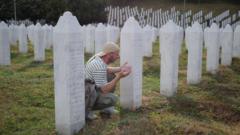More than 8,000 Bosnian men and boys lost their lives at the hands of Bosnian Serb forces in Srebrenica during July 1995. As the world grapples with this tragic history, new reflections emerge during the world premiere of "Flowers of Srebrenica" at Sarajevo's War Theatre. This play confronts the lingering grief and unresolved issues that continue to divide Bosnia and Herzegovina nearly three decades later.
The Srebrenica massacre remains a painful reminder of the most heinous war crime on European soil since World War II. Bosnian-Serb forces invaded Srebrenica, a supposed safe haven for thousands of Bosniaks, mostly Muslims, under UN protection. Tragically, Dutch peacekeepers stood idly by as General Ratko Mladić orchestrated the cruel expulsion of women and children, followed by the systematic execution of approximately 8,000 men and boys in the fray. The aftermath saw the perpetrators hiding evidence through mass graves, leading to decades of anguish for the victims' families, many of whom continue the search for closure.
The haunting elements of the play echo the grim reality of identifying the victims through the remnants of their clothes and personal belongings, emphasizing the painful search for answers and the struggle for justice. While the audience in Sarajevo applauded the production, divisions persisted, particularly in the majority-Serb entity of Republika Srpska, where political leaders continue to deny the genocide’s occurrence, despite international judicial convictions of Mladić and Radovan Karadžić.
Lead actress Selma Alispahić, a former refugee from the war, articulated the exhaustion felt within the communities. "People get tired of proving the truth that's been proven so many times," she lamented. As tensions remain palpable, the Dayton Peace Agreement, which halted the war in late 1995, has instead entrenched divisions along ethnic lines, splitting Bosnia into two entities: the Federation, populated primarily by Bosniaks and Croats, and Republika Srpska, home to a majority of Serbs.
Recent developments in Republika Srpska, particularly efforts from its president Milorad Dodik to withdraw from national institutions and establish a "reserve police force," evoke memories of past ethnic violence and deepen concerns over the stability of the region. Christian Schmidt, the international High Representative for Bosnia, has condemned such maneuvers, asserting that they threaten to resurrect past horrors.
The annual commemorative events serving to honor the victims of the massacre, however, contrast sharply with the lack of recognition in East Sarajevo. As members of the community gather to honor those lost, alongside the criticisms directed at the reductions in historical acknowledgment by some leaders, it is clear that a divide remains.
Mirela Osmanović, who lost two brothers during the massacre and now works at the Srebrenica Memorial Centre, expressed concern over the recent surge in ethnic tensions. She shared, "The intense atmosphere produced by Republika Srpska's leaders really disturbs us, making us feel we're not protected anymore." Her experiences reflect the ongoing pain that lingers, overshadowed by modern-day political tactics that hinder healing and threaten to reignite old wounds.
As Bosnians grapple with this complicated legacy, the struggle for truth, recognition, and accountability amidst the turbulent political landscape remains a focal point, underlining both the historical significance and contemporary impact of the Srebrenica tragedy.









